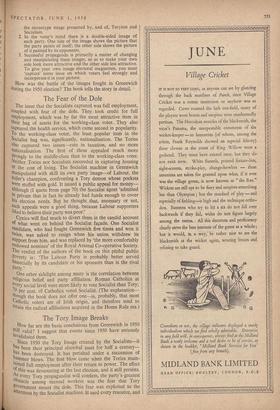The Tory Image Breaks
How far are the basic conclusions from Greenwich in 1950 !rill valid? I suggest that events since 1950 have seriously invalidated them.
Since 1950 the Tory Image created by the Socialists—it has been their principal electdral asset for half a century— has been destroyed. It has perished under a succession of hammer blows. The first blow came when the Tories main- tained full employment after their return to power. The effect of this was devastating at the last election, and it still persists. As every Tory propagandist will confirm, the party's greatest obstacle among manual workers was the fear that Tory government meant the dole. This fear was exploited to the uttermost by the Socialist machine. It used every resource, and it laid aside every scruple, in order to spread the belief that the Tories stood for a pool of unemployed.
Up to 1945. Socialist propaganda was built on Hope as well as Fear—hope of a happy land where poverty had been banished, where all would be gas and Dr. Temple, and the worker would come into his own. But in each election since 1945 it has dealt only in Fear—fear of unemployment, fear of atomic war, both of them linked to the Wicked Tory. In the 1951 election, when the machine faced defeat. Transport House issued the notorious leaflet which said in so many words, 'The Tories would not object to nearly two million unemployed.' But in 1955. after four years of peace and full employment under Toryism, neither cock would fight.
The second blow at the Tory Image has been struck on the television screen. In 1950, there were about 400,000 TV licences; by 1955 there were ten times as many. Nobody grasped the implications of that boom faster than Lord Woolton. Of all his achievements during his reign at Central Office none is likely to be of more enduring importance to his party than his exploitation of television.
The decision to televise the Tory Party conference at Blackpool in 1954 was the greatest feat of political skill in Tory history since Disraeli leaped in the dark in 1867 to wrest household suffrage from the Radicals. Dizzy's ghost must have exulted in Uncle Fred. In a single evening multitudes of viewers who never had been and never would be lured to a Tory meeting saw and heard, for the first time in their lives, what the Tory Party was really like. An historic personage fell dying that night; the Tory of the Low and Vicky cartoons, the fat man swollen with wealth, insolence, and Kensingtonian vowel sounds. The Tories on the TV screen, with their medley of classes, clothes and accents, brought an era to an end. In every one of the Tory TV transmissions, Woolton and his advisers went straight for the Wicked Man. They were out to kill him; and kill him they did.
This act of justifiable homicide was made easier by the discovery of Miss Edith Pitt, MP for Edgbaston and now Parliamentary Secretary to the Ministry of Pensions and National Insurance. For Miss Pitt is a portent of the new Toryism, on the TV screen and off it. A working-class girl who went to a State school and who reached Parliament through Tory working-class politics in Birmingham, Miss Pitt retains her Midland vowel sounds; she is at the polar extreme from lah-di-dah. She is a serious politician, who has escaped the fate of almost every other MP with a broadcasting reputation—popularity outside Westminster, nullity inside it. If the Tory Central Office experts continue to know their job. Miss Pitt will be a major asset of the party at the next election.
The old images, Tory and Socialist alike, that have dominated British politics for a generation, have both been shattered since 1951. Toryism has been freed from its greatest electoral handicap. But Socialism has suffered. For with the revolutionary changes, present and to come, in the manual worker's economic climate, he is less and less willing to see himself as Labour Voter, Kcir Hardie model. (There are many signs, in clothes and habits, that he is moving towards an American stereotype.)



































 Previous page
Previous page